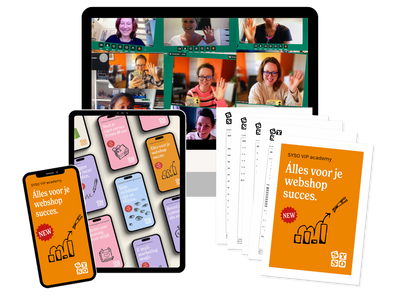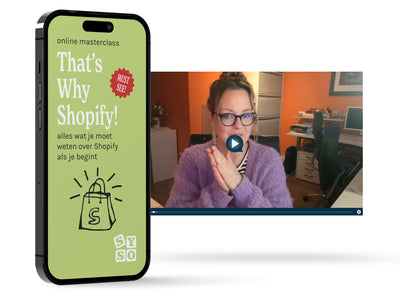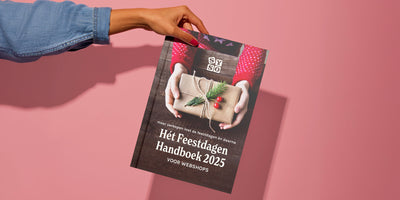CoolBlue is doing well, with a turnover of 2.35 billion euros in 2022, the online giant will probably be in 2nd place in the Twinkle100 again this year. A great achievement, especially when you see that CoolBlue , unlike number 1 Bol, is not a platform with external sellers.
I would like to see what we can learn from CoolBlue, not only as a corporation, but also as a small to medium-sized online retailer. In my search for a new washing machine, I look at how CoolBlue distinguishes itself from the competition. Will you watch with me?
Reach your target group
My search for a washing machine traditionally starts on Google. CoolBlue appears easily there in both Google Ads and organic results. Now CoolBlue has the luxury of being found organically for almost every search term and sufficient budget for a good Ads Campaign. Your financial buffer is probably slightly smaller. Yet it is important to reach your target group. The buyer I would like to mention as the first lesson is; knows how to reach your target group.
It's about the entire customer journey
When you arrive at the (trusted) CoolBlue website, the simplicity is striking. The information is clear and concise and it is very clear where the “Add to Cart” button is located. This button always remains visible while scrolling. On my mobile the experience is even better; There too, the order button remains clearly visible and everything works very intuitively.
CoolBlue boss Pieter Zwart* made the famous comment during the ING Business Boost in Rotterdam: “E-commerce is the dumbest business model in the world! … You have a picture, a price and a button. Selling washing machines is not at all about a picture, price or button. It's about the entire customer journey.” That seems obvious, the word “customer experience” seems like a real hype. Yet few online stores actually succeed in putting this into practice.
* source: Frank.news
Making an online store truly intuitive and simple is extremely complex. Many online stores (& websites) have a tendency to provide too much or the wrong information. It is not without reason that I often hear from online retailers “Customers don't read” and that is true. The only solution is not to encourage customers to read, but to present the information differently.
Of course, the customer journey does not end there. Payment, order confirmation, delivery, the package and contact with customer service are all part of the customer journey. All these steps must be improved in detail and fit together.
I often hear from online retailers: “I sent the package on time, but the delivery person made a mess of it.” Completely true and frustrating, yet it doesn't matter to the customer. The customer just wants to get his package home on time. Who's fault it is if that doesn't work doesn't matter for his frustration.
What you can learn from this as an online retailer:
- it is very complex to keep things simple.
- all steps in the process must connect with each other (success is in the details)
- a customer does not buy a product, but a need, which also includes delivery
Help customers choose
Part of the customer journey is of course choosing the product. CoolBlue helps the customer in a very simple, yet effective way.
CoolBlue divides the customer into certain groups and recommends the best product for each group. In my search for my washing machine, I came across the following groups:
- our choice for a washing machine for a single or couple
- our choice for an energy-efficient washing machine
- our choice for a washing machine for a family with one or two children
- our choice for a washing machine for a large family

Very simple, but I only come across this option in so few online stores. With competitors such as BCC, Expert and Mediamarkt, it is also an option to select a target group and I also see some advice stickers. However, I don't see a recommended choice per target group anywhere.
CoolBlue's product representation also differs. I see little information at competitor BCC; just a meaningless intro with a “Read more” button. At the Mediamarkt I am again bombarded with information such as “carbon brushless motor” - probably very useful to know for the consumer who has already done some research. Expert limits the display to three relevant pieces of data. Yet CoolBlue also goes a step further here; by translating the energy label into an average saving in euros per year. Of course, that's what it's all about in the end!
CoolBlue is the only party to show that the average customer has no desire to delve into all the product specifications. That customer simply wants to be helped with his choice. Is there a customer who would like to delve deeper? He can then use the filter and comparison options to retrieve all specifications.
When it comes to the product itself, CoolBlue clearly explains the advantages and disadvantages of the product. This way you help the customer make the right choice. This not only prevents unnecessary returns, it also ensures that the customer trusts the benefits better. It prevents the feeling that the seller only mentions the advantages of selling directly. I don't see any disadvantages with BCC and Mediamarkt, but Expert has managed this well. The only thing missing is proactive reference to models that do not have the aforementioned disadvantage.
What you can learn from this as an online retailer:
- help your customers choose by prominently recommending one product per target group
- know what information your consumer finds relevant as concise information, don't show too much
- also mention the disadvantages of your product, not just the advantages

Everything for a smile
CoolBlue's slogan is “Everything for a smile”. In my opinion, that is not just a nicely chosen slogan. It has really been implemented into the DNA of the organization.

The website has some nice nods, such as: “Productenpolonaise” in the shopping cart, after checkout there is “waiting therapy”, the delivery box has the text “correct” as a joke and the package is sent in a playful box. All these things really make me smile, precisely because it is so subtle and different from what I am used to elsewhere. Ordering from CoolBlue gives you a good feeling.

These are just a few examples of how CoolBlue really implements the slogan into their corporate culture and the entire customer journey. By really going for a clearly distinctive vision, you can also achieve this as an online retailer. What really sets your company apart from the competition?
Many online retailers say they distinguish themselves through service, which is very nice. However, not everyone can distinguish themselves on service. If everyone does it, it will become the standard. Service therefore goes beyond what is expected. If service is your differentiating factor, how do you exceed customer expectations in practice?
What you can learn from this as an online retailer:
- service is not doing what the customer expects, but going beyond what the customer expects
- To distinguish yourself is to do things slightly differently (than the competition)
-
experience is not just a beautiful website; it's about every contact moment
Interpreting = learning
I wanted to use the heading “measuring = knowing” for this paragraph, but that has now become such a cliché that I have changed the heading. Measuring sometimes seems to have become a goal in itself.
If you collect all kinds of data and can show nice graphs, but then make all decisions based on gut feeling, then you might as well not measure anything. Targeted measurement, the correct interpretation and also daring to refute your gut feeling is just as important!
It is therefore important to determine what you measure, why you measure it and what you will then do with that information. It is precisely the interpretation of all that data that is important. Data is not a goal, but a means.
For example , CoolBlue uses the search behavior of customers . With that data they can determine whether there is demand for a product with certain specifications for a certain price. For example, CoolBlue discovered that there was a demand for an Apple MacBook with “absurd specifications” for 3,300 euros. This MacBook didn't exist yet, so CoolBlue asked Apple to make it. This MacBook became a sales success.
Now, not everyone is a CoolBlue and you may be the data team yourself. Yet you can also measure a lot as a medium-sized or small online retailer.
This way you can measure which search filters customers use. For example, do customers often search for a certain combination of filter options, but is the range limited? Then you can expand your range in that area. Does it appear that a product with certain specifications is not often viewed or searched for via the search function? Then you may consider removing this product from your range.
For CoolBlue, one of the most important indicators is customer satisfaction. Just like CoolBlue, you can also measure your customer satisfaction, for example with customer reviews . You can not only use the result internally, but also publish it on your website to show customers that your customer service is in order. After all, not everyone is as well known as CoolBlue. Especially if you are less known, you need to inspire the visitor's trust.
These are just two examples of how you can measure as a (small) online retailer. With some brainstorming you can probably come up with a lot of ways to use data or make informed decisions.
Getting better and better
Is there no room for improvement at CoolBlue? Certainly! For example, I didn't receive an email until 2 a.m. at which time my washing machine would be delivered the next day. So I had to check early in the morning whether my washing machine wouldn't be at my door at 7:30 am. The agreed delivery time (between 12:25 -13:25) was also not met. That can happen of course, but an update on this by e-mail or text message would be nice.
That is the last lesson; It can always be better! As an online retailer you are never done…
About the author
Marcel Landeweerd is the founder of the WebwinkelKeur Foundation . A modern online store quality mark including customer reviews.
Out of dissatisfaction with existing quality marks that were both too expensive and too old-fashioned, Marcel started WebwinkelKeur in 2011. WebwinkelKeur measures the reliability of an online store through manual control, automatic software and customer reviews. This approach proved successful; within 7 years the quality mark grew into the largest Dutch quality mark.








